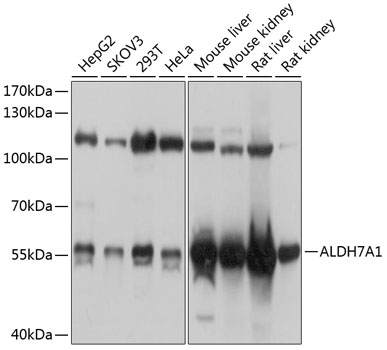ALDH7A1 antibody
GTX103593
ApplicationsImmunoFluorescence, Western Blot, ImmunoCytoChemistry, ImmunoHistoChemistry, ImmunoHistoChemistry Paraffin
Product group Antibodies
TargetALDH7A1
Overview
- SupplierGeneTex
- Product NameALDH7A1 antibody
- Delivery Days Customer9
- Application Supplier NoteWB: 1:500-1:3000. ICC/IF: 1:100-1:1000. IHC-P: 1:100-1:1000. *Optimal dilutions/concentrations should be determined by the researcher.Not tested in other applications.
- ApplicationsImmunoFluorescence, Western Blot, ImmunoCytoChemistry, ImmunoHistoChemistry, ImmunoHistoChemistry Paraffin
- CertificationResearch Use Only
- ClonalityPolyclonal
- Concentration1 mg/ml
- ConjugateUnconjugated
- Gene ID501
- Target nameALDH7A1
- Target descriptionaldehyde dehydrogenase 7 family member A1
- Target synonymsATQ1, EPD, EPEO4, PDE, alpha-aminoadipic semialdehyde dehydrogenase, 26g turgor protein homolog, P6c dehydrogenase, alpha-AASA dehydrogenase, antiquitin-1, betaine aldehyde dehydrogenase, delta1-piperideine-6-carboxylate dehydrogenase, epididymis secretory sperm binding protein
- HostRabbit
- IsotypeIgG
- Protein IDP49419
- Protein NameAlpha-aminoadipic semialdehyde dehydrogenase
- Scientific DescriptionAntiquitin is a member of subfamily 7 in the aldehyde dehydrogenase gene family. These enzymes are thought to play a major role in the detoxification of aldehydes generated by alcohol metabolism and lipid peroxidation. This particular member has homology to a previously described protein from the green garden pea, the 26g pea turgor protein. Mutations in this gene cause pyridoxine-dependent epilepsy, which involves a combination of various seizure types and is responsive to immediate administration of pyridoxine hydrochloride. Four additional human antiquitin-like sequences, all of which are pseudogenes, have also been identified. [provided by RefSeq]
- Storage Instruction-20°C or -80°C,2°C to 8°C
- UNSPSC12352203





